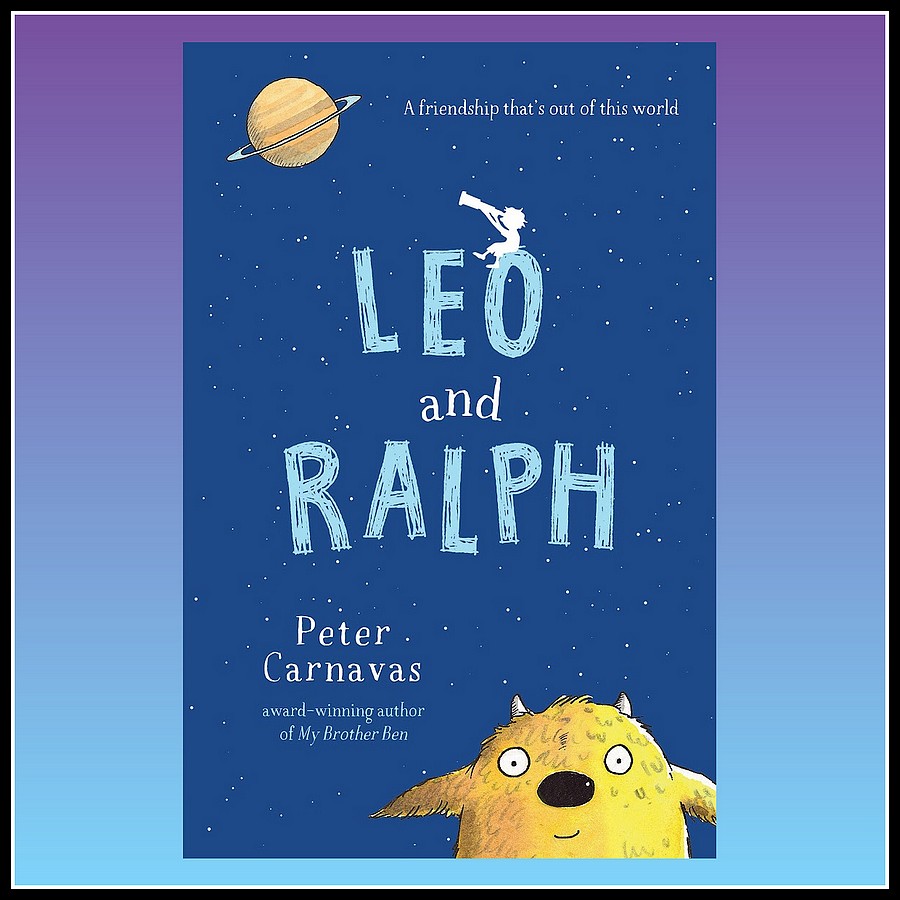
Title: Leo and Ralph
Author and illustrator: Peter Carnavas
Publisher: University of Queensland Press (UQP)
Publication date: February 2024
Themes: Friendship, imaginary friends, alienation, vulnerability, acceptance, space.
Teachers’notes are available from the UQP website here
Leo’s imagination, full of wonderings; his imaginary friend, Ralph, an alien whose fur changes colour to reflect his mood, together with a colourful, spunky teacher, Ms Pengari, who themes her outfits to her lessons, all take centre stage in Leo and Ralph, published by the University of Queensland Press. This is a touching story about the power and beauty of true friendship, finding your voice and how flexing your imagination muscle can help navigate unchartered territory and transform the world around you. This story will take readers on Leo’s journey of self-discovery as he learns lessons about himself, leans into stepping outside his comfort zone and discovers how to use his strengths and skills to realise his hopes and wishes.
Leo struggles to connect with his peers, not for lack of trying. He is dismissed by his classmates who brush him off as they do not take the time to get to know Leo and what makes him tick. Leo finds the games in the playground confusing and chaotic and he struggles to communicate his thoughts to his peers, his words get stuck, so he spends his lunchtimes often alone. It is in this solace that he contemplates the world around him as he is highly curious and ponders a lot of questions and what ifs?
One topic that Leo deeply loves and is fascinated by is space and his inquiring mind drives him to learn more about it. Leo finds comfort in observing the sky, the massive, limitless expanse, where one’s mind can truly wonder about possibilities and question what might be. Thinking about the stars, constellations and planets has Leo fascinated about other worlds.
One day, Leo spots a white balloon floating across the sky. This sighting transforms his life as it heralds the arrival of Ralph from Ralphora, who soon becomes Leo’s loyal best imaginary friend. They share a love of space and enjoy blissful nights together staring up at the stars, imagining and inventing planets, what they look like and who they are home to. The even invent a language together. Their days are fun filled, carefree and space inspires many of their games and conversations. You always know when Ralph is around because Leo has his little finger out because Ralph is holding onto it.
Leo has a very strong family network consisting of his Mum, Dad and younger sister, Peg. They are initially very supportive and inclusive of Ralph, for example, they wait for him to secure his seatbelt and set a table space for him. Ralph provides companionship for Leo, making him feel happy, safe and less alone at school.
A promotion for Leo’s Mum sees the family move from the city to a small country town, Dundle. This means Leo must say goodbye to Ralph, his imaginary friend of nearly four years. A move of this magnitude is full of change and leaving behind your first best friend is very challenging. Leo has the unwavering support of his family, a new teacher, Ms Pengari who believes in him and with a nudge from Ralph, he connects with Gus, a real-life friend. The two strike up an unlikely friendship. They are different in many ways, however it is these differences that help their friendship thrive. They make a formidable team as they introduce each other to new things, ideas and ways to approach life. This friendship helps Leo find his voice
My copy of this book is covered in post-it notes as there are so many sentences and paragraphs which I read over and over as the imagery struck me, so beautifully expressive. I am going to be using a lot of quotes from this book in my library lessons, it is perfect to illustrate the show don’t tell concept and is brimming with examples of this. For example, “Leo nodded, but a small weight of worry, the size of a pumpkin seed, sprouted in his chest. It grew like a vine and snaked inside him…. The worry vine exploded into a tangled knot of tendrils and thorns prickling his insides”. (p94) Another description, “Dundle was orange-brown. And oven hot. As Leo stood with his family on the footpath of the main street, he felt like a blob of dough crisping into a biscuit. Or a square of chocolate melting into sticky goo”. (p108). Then there are the wildly vivid descriptions that bring Ms Pengari to life. A teacher that students will talk about years later and reminisce about the treasured memories they have tucked into their hearts all made by Ms Pengari. She is a teacher that personifies kindness, fun and radiates warmth, a teacher that makes school a memorable and rewarding experience. The illustrations peppered throughout the book add another layer to the story, empowering readers to build deeper connections to the characters and setting.
Hope, courage and humour sensitively balance the heavy themes in this story of self-discovery and acceptance. Many readers will relate to the characters and see themselves in similar situations; this will be an affirming story for them and anyone who has felt misunderstood. For others, this will be an opportunity to step into someone else’s shoes and could be a gateway for self-reflection and conversations. This book would be perfect to read aloud and share with children 9+.
